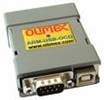UK Schools Micromouse 2009
By Bernard Grabowski
The 2009 National Schools and Colleges Micromouse competition took place on Saturday 27th June at the Technology Innovation Centre in Birmingham. The team from John Hampden Grammar School were once again strongly represented. They have dominated the event for several years but this time were pushed to the limit by teams from three debuting schools. Competition was intense and new event best times were recorded. The existing drag race record (2.132 seconds, set last year by the team from Singapore) was smashed several times and now stands at an incredible 1.699 sec. The track is just less than 7m in length and the mouse had to stop under control within 1m beyond the finish line. Peak acceleration must now be around 1g in this event and braking has to start at just past the halfway mark.

 While I have a couple of STM32 development boards already, I was looking around for something a bit more flexible. Somehow, development kits always seem to have the wrong set of peripherals and pins I want to play with are not available. After a bit of hunting, I came across this board, made by ETT. It comes in a convenient, small size with two single rows of pins for the IO. Perfect for plugging into a breadboards for some proper playing…
While I have a couple of STM32 development boards already, I was looking around for something a bit more flexible. Somehow, development kits always seem to have the wrong set of peripherals and pins I want to play with are not available. After a bit of hunting, I came across this board, made by ETT. It comes in a convenient, small size with two single rows of pins for the IO. Perfect for plugging into a breadboards for some proper playing…

